Settling In
The Copping Family
1822
Rawdon
George Copping age 41
Elizabeth Mallion Copping age 40
George William age 15 years
William George age 14 years
John Charles age 12 years
Clarinda age 10 years
James age 8 years
Thomas Henry age 6 years
Henry Thomas age 4 years
Mary age 1 year
Clearing and Building a home
George and his boys, George, William, and John, chopped and burnt every day through spring into summer. Finally there was adequate space to build as well as the logs to build a cabin.
A cellar had been be dug out and lined with small logs to store their potatoes and all other such provisions during the winter. The house was erected over this space.
A bee made good work of getting the walls of the house up and a start on the roof made.
Holes were then cut in the walls for a door and a window. To conserve heat usually only one window was in a cabin.
The gables were boarded and the shingling began.
Elizabeth waited with great anticipation for the completion of the cabin.
At the end of summer, while he house was not completely finished, the family moved in.
They had a roof over their heads once again!
Before the frost came, the outside of the house was banked with earth to about a foot high around the foundation. This was done to protect the cellar from frost and limit cold drafts blowing through the house during the winter.
The family lived and expanded in this dwelling for the next fifteen years.
Elizabeth, Clarinda and James set about winterizing the cabin. The walls had to be carefully examined and any holes chinked with a mixture of moss, clay, and lime.
When the first snow arrived it would be shovelled against the sides of the cabin to help retain the heat from the one stove that provided both a cooking surface and heated the home.
Despite their efforts, during the coldest winter days, the temperature in the cabin fell well below freezing temperatures. The ladies suffered from chapped hands and cracked fingertips. A bit of lard rubbed well into the hands helped relieve the condition. In later years, when there was wool to spin, the lanolin provided some lubrication for their hands but the first winter there was no wool to spin or knit.
Inside Their New Home

A stove to provide heat as well for cooking was the focal point of the living area. A table with benches, and a few chairs were the main pieces of furniture. A wash stand with a tub and scrubbing board, a butter churn, and a small stand by the door with a pail to hold water completed the collection. The room was lit with a candle placed on a table.
Whether made in the home, bought or traded, the contents of in the Copping home were hand made.

While a kitchen was the main room downstairs, a smaller section was used for sleeping quarters for the parents and infants. Clarinda being the only girl, had a bed in a corner curtained off.
Although a cabin was basically a single storey a ladder toclimb up to loft was used for sleeping quarters for the boys. Simple beds, or sometimes just straw spread on the floor was the only furnishing in the loft. Heavy blankets covered the boys, or if they were very lucky, a buffalo protected them from not only the cold, but any snow or rain that crept in through the cracks.
Spoons, bowls and many other articles were carved from wood.
Woodenware
Earthen ware was also manufactured in local areas including St Jacques de Montcalm. Various shapes and sizes were used for food storage. Large crocks held salted meat or pickles. Jugs kept milk, wine, or syrup.
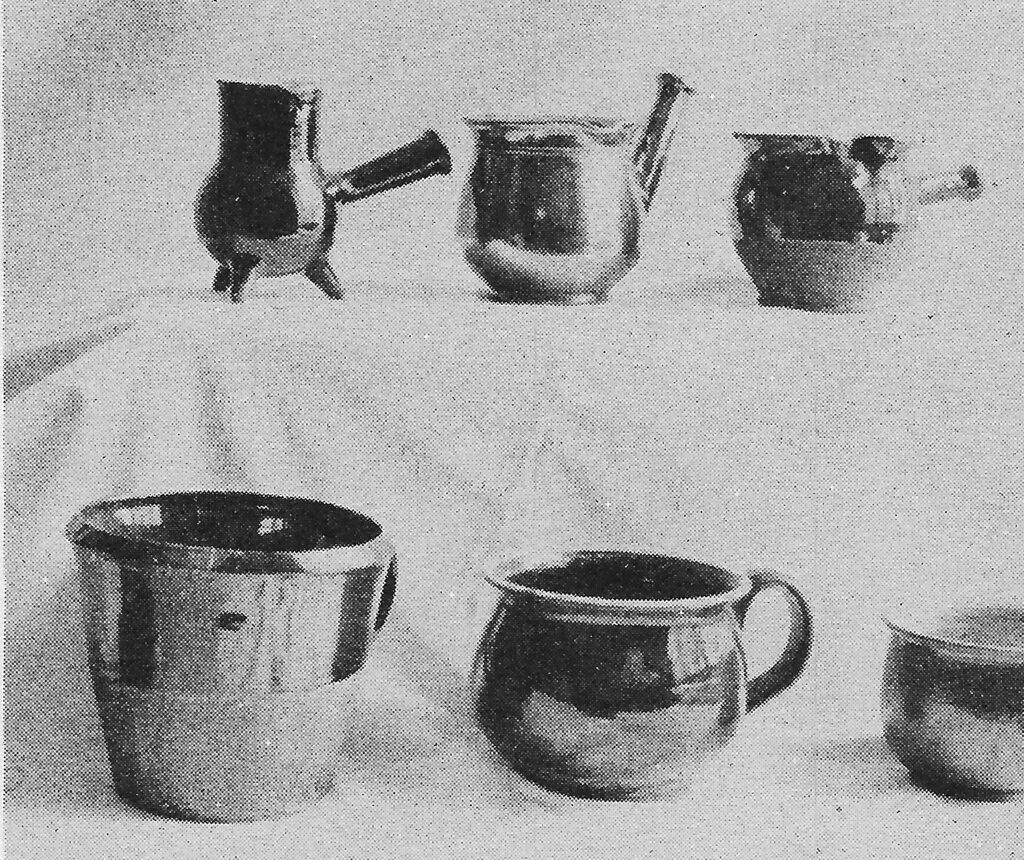
Hand Carved Wooden Ware
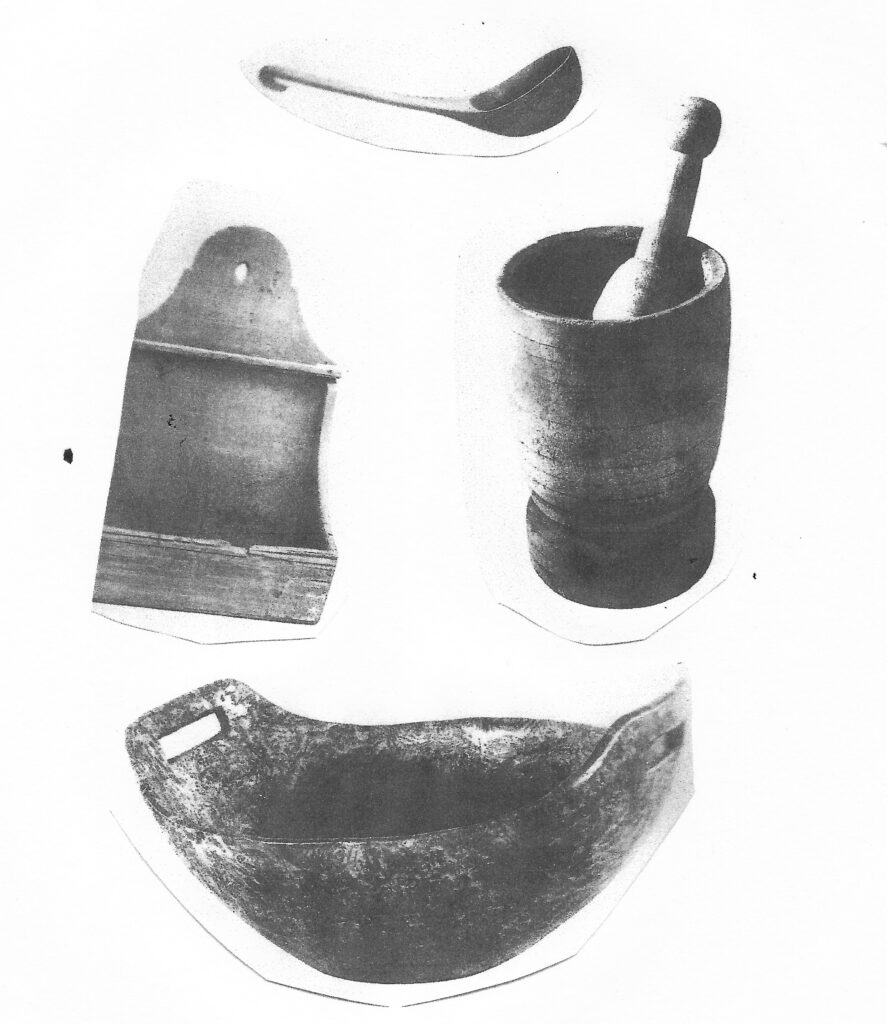
The matchbox would not be in the earliest settlers’ home. In fact the Coppings were gone before safety matches came onto the market.

The first years in Rawdon a cradle was needed in the Coppings’ home. Notice the small wooden hooks on the cradle. Strips of linen were wound across the cradle to prevent an older baby from crawling out of the crib.
At this time babies did not crawl on the floor, when removed from the cradle they were kept on the knee.
Cradles were passed down through families, possibly son George would have inherited the Copping cradle.
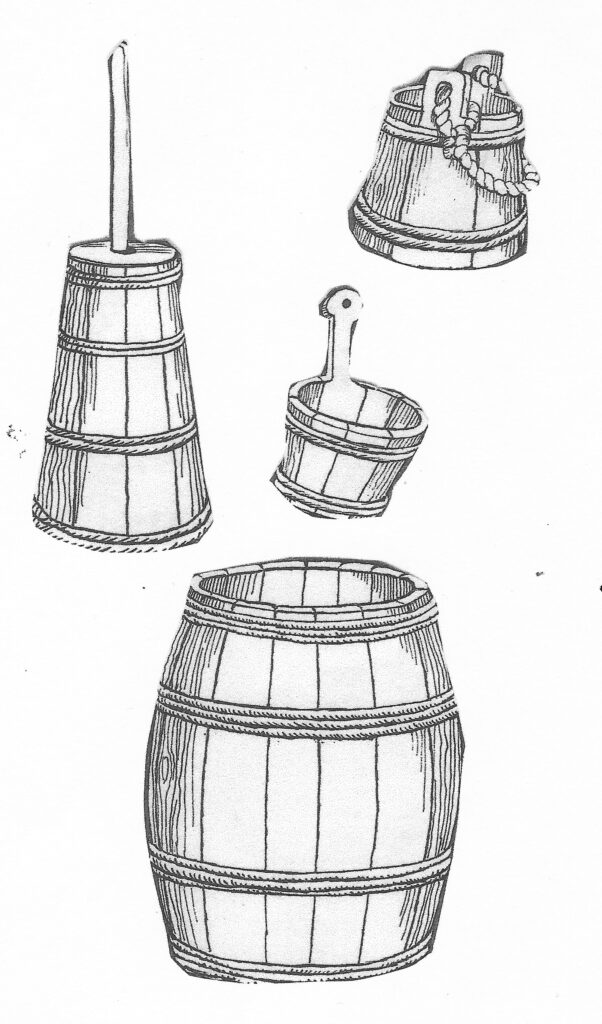
Note all these items were hooped with rope made on the farm rather than metal straps.
In the Rawdon settlement William’s son, John, profited from the many days in winter the weather prevented him from working to make oaken ware, buckets, particularly. He became known as “Bucketshop”.
Iron Ware
Besides Les Forges St. Maurice there were several lesser iron works in Quebec. In Montreal two of these made stoves as well as smaller ware.
Kettles and pots, being made of iron were very heavy, particularly when full.
The weight helped prevent the very young from tipping them but scalding and burning were still frequent occurrences in the early days.
Elizabeth was called to help when a little Marlin child was severely scalded. She tended his wounds for several days and was credited with saving the child’s life.
Earthenware
Tinware
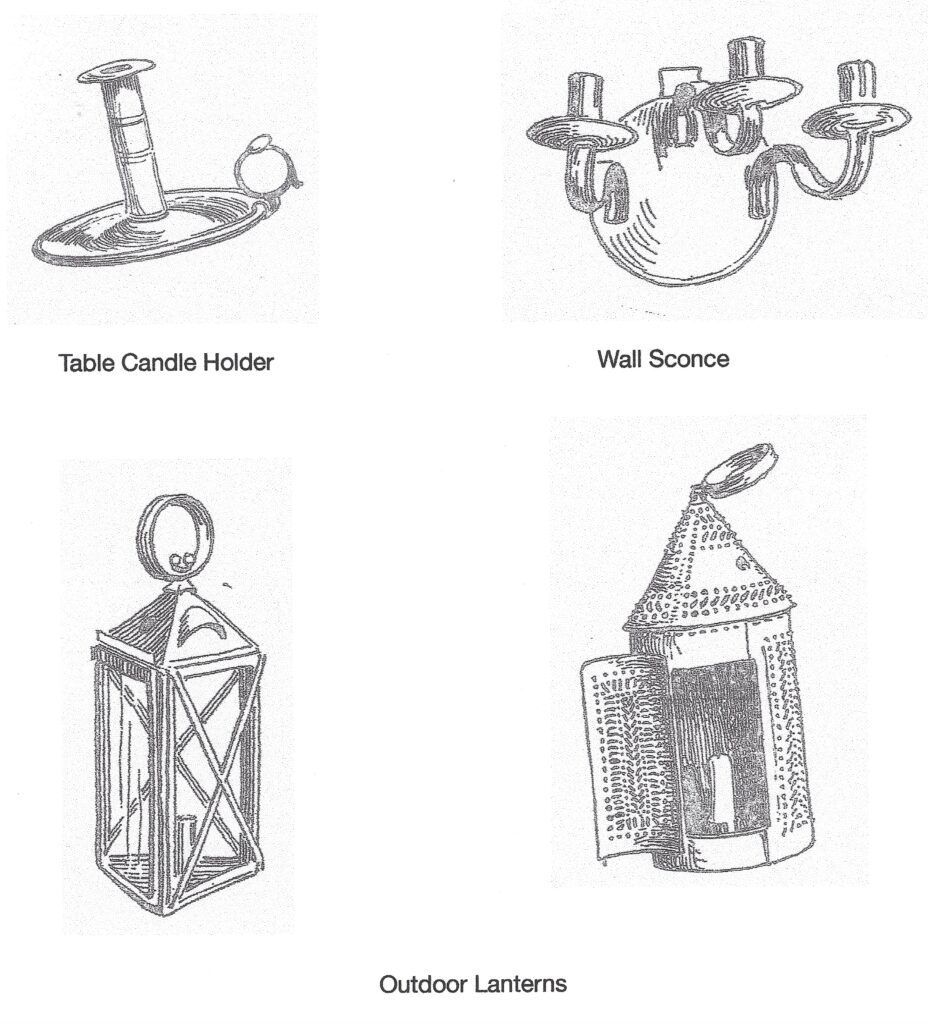
Candle holders were bought at the tinsmith or the general store. Most families used a very simple holder for a single candle but there were various other types which held two or more candles. There was a choice of table models and wall sconces. The table models were more easy to knock over and cause a fire, but it was also possible to carry them from room to room.
With the early fall of darkness in winter, sometimes light was needed outside, as well. For a visit to the stables or hung on the side of a sleigh a holder to protect the candle from the wind was essential. A simple housing of punctured tin, although the least effective, was the usual model. A more sophisticated type designed with glass enclosed metal frame was much more effective, but was also more costly and easier to break.
Wicks for the candles were woven from cotton thread. The thickness and texture of the wick was very important, too thick or too thin, too loose or too tight affected the amount of light the candle gave.Tallow for the candles was available in the fall at butchering time. The fat from a cow or sheep was rendered to make tallow.
Wicks were measured for length, dipped into melted tallow and hung to dry. This procedure was continued several times until they were the desired thickness. Molds for candles were available but dipping was the usual method used in a settler’s home.
Candles were the only source of light during George and Elizabeth’s lifetime. Coal oil or kerosene lamps only came into general use in the 1860’s. Safety matches were only available in this era as well.
Ironware
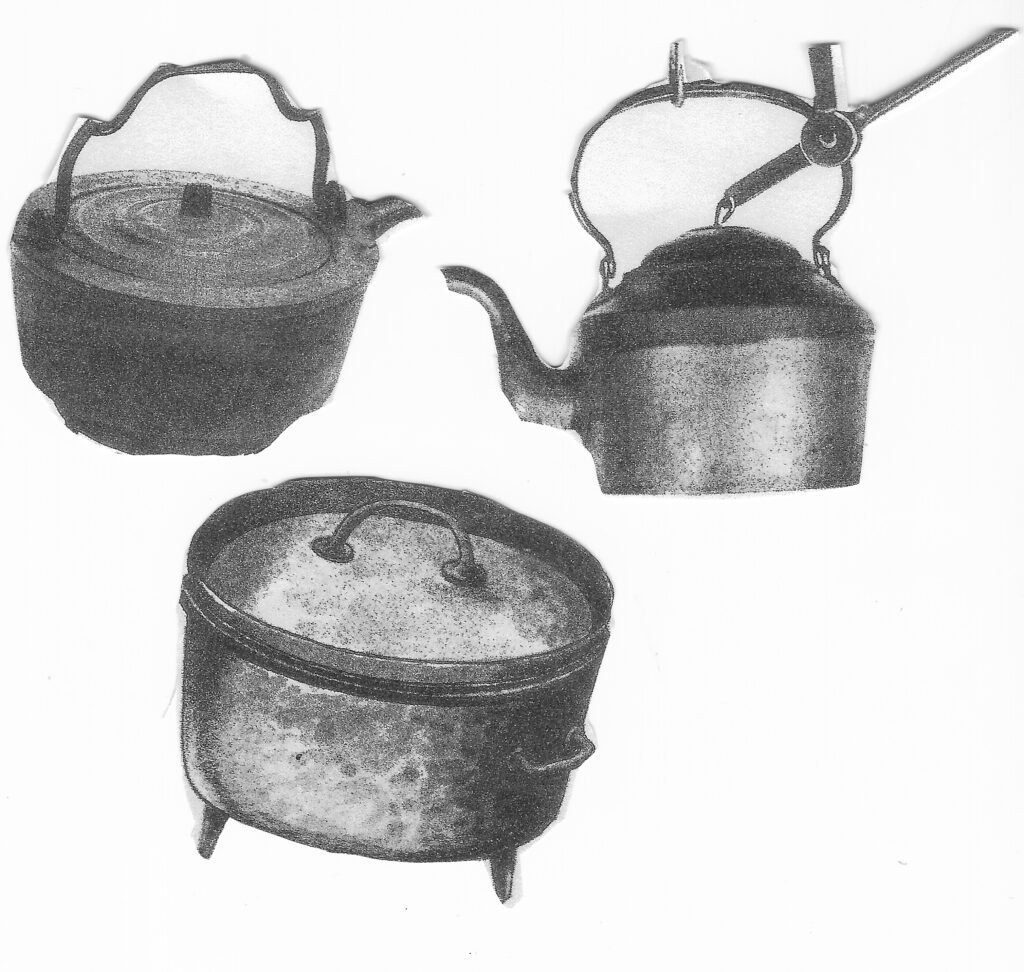
Cooking was done in iron pots, kettles for hot water. The weight of the iron was considerable, it is difficult to consider the strength it took to lift a pot or kettle when it was full. Ladies were no frail creatures.
The weight might make tipping more difficult, all the same Elizabeth was called to attend many cases of severe scalding from such accidents. She was credited with saving the life of a severely scalded child at their neighbour. She made many trips down to her grandchild, George, son George’s oldest boy who had suffered life threatening scalding.
Although the furnishings of the Copping cabin might seem very primitive, conveniences minimal, the preparation of meals time consuming, it must be noted that this was a reality of the 1820. In many respects comparative to those in Great Britain.
Rural European homes were no more comfortable, in fact often less so. The log cabins of the settlers were often brighter and much less smoky and damp than European homes. Admittedly, the winter cold was greater, the temperature in the house sometimes fell well below freezing. Water standing in pails froze. This still happened in the 1950’s in both Canada and Great Britain.
This was the reality of Elizabeth’s life in the township – very little in conveniences, no luxurues!
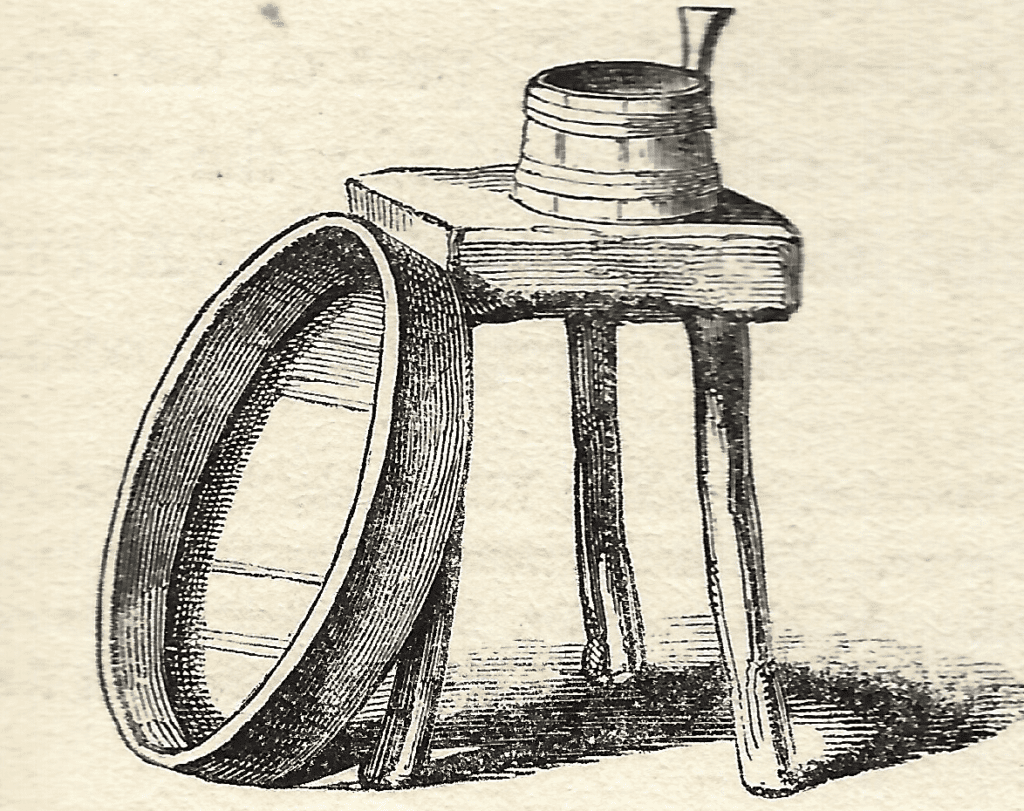
While it may occur to some that furnishings in the wilds of Canada were rather difficult, let us take a look at what was found in Great Britain. The seive, stool and dipper above were found throughout Great Britan in the same era.
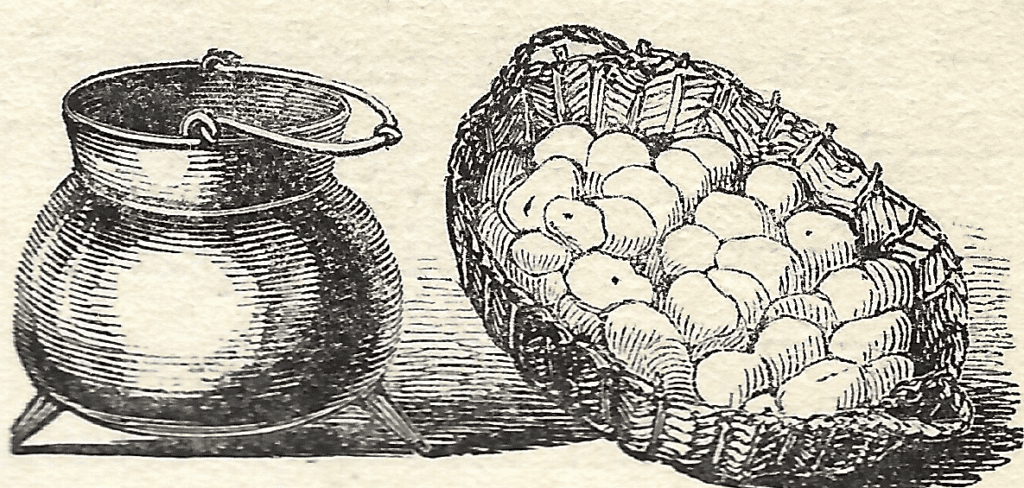
The steel pot and woven basket were also found in the homesin Great Britain.
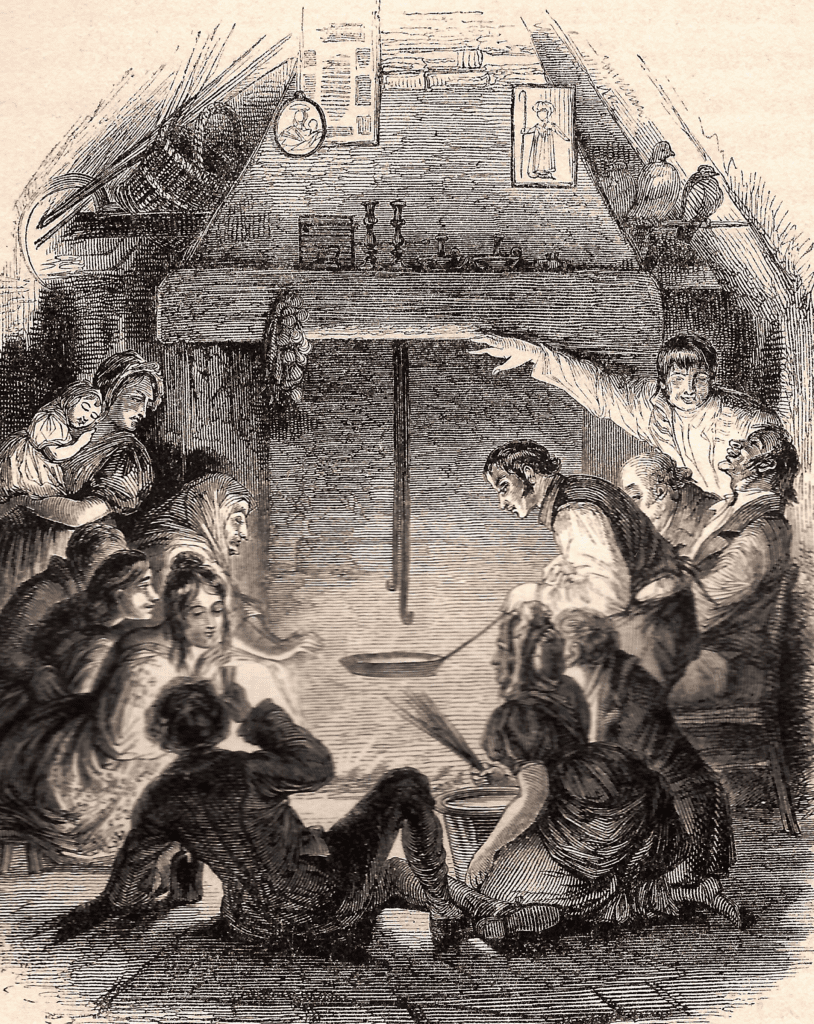
Above is a sketch of a group celebrating the beginning of Lent on Shrove Tuesday gathering to celebrate a Pancake Toss.
Note the open fireplace heated with twigs or peat. In Rawdon stoves, manufactured locally and available at a reasonable cost used for cooking and heating.